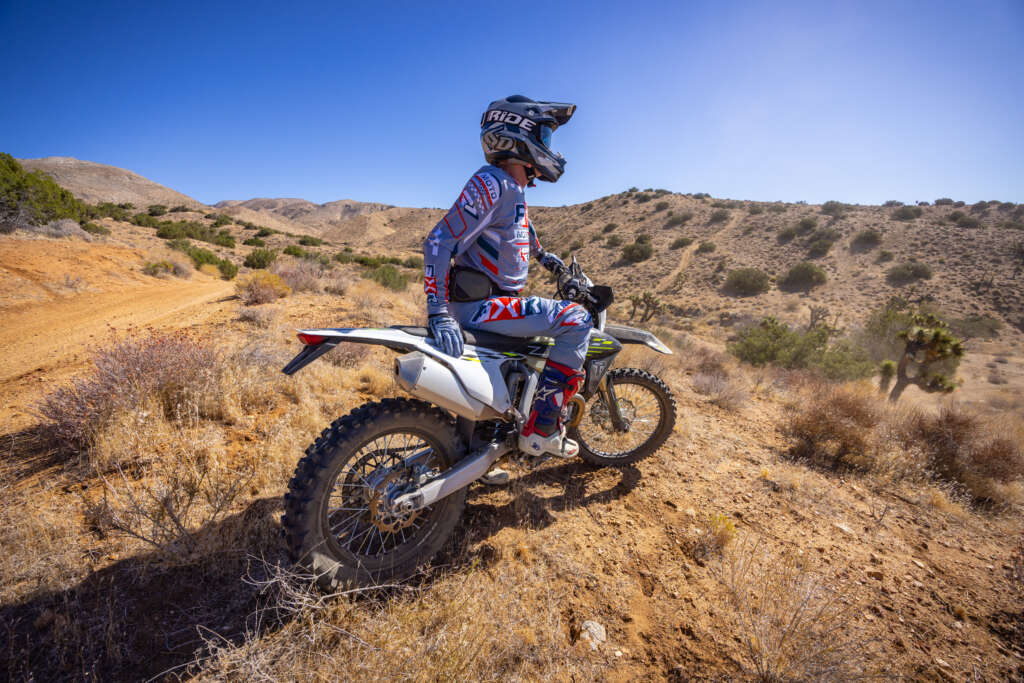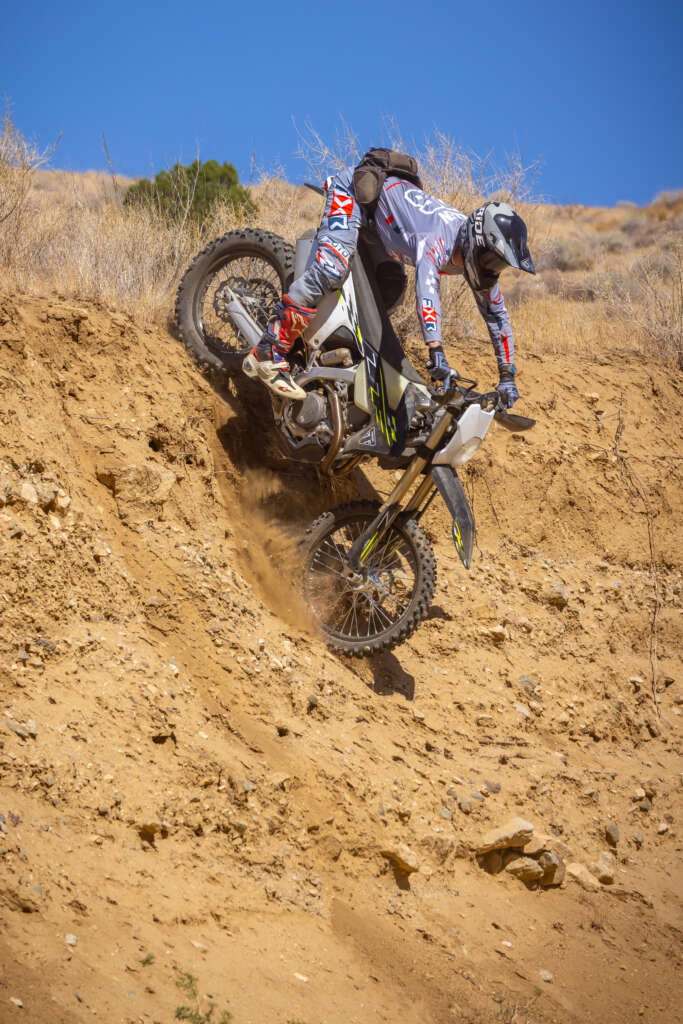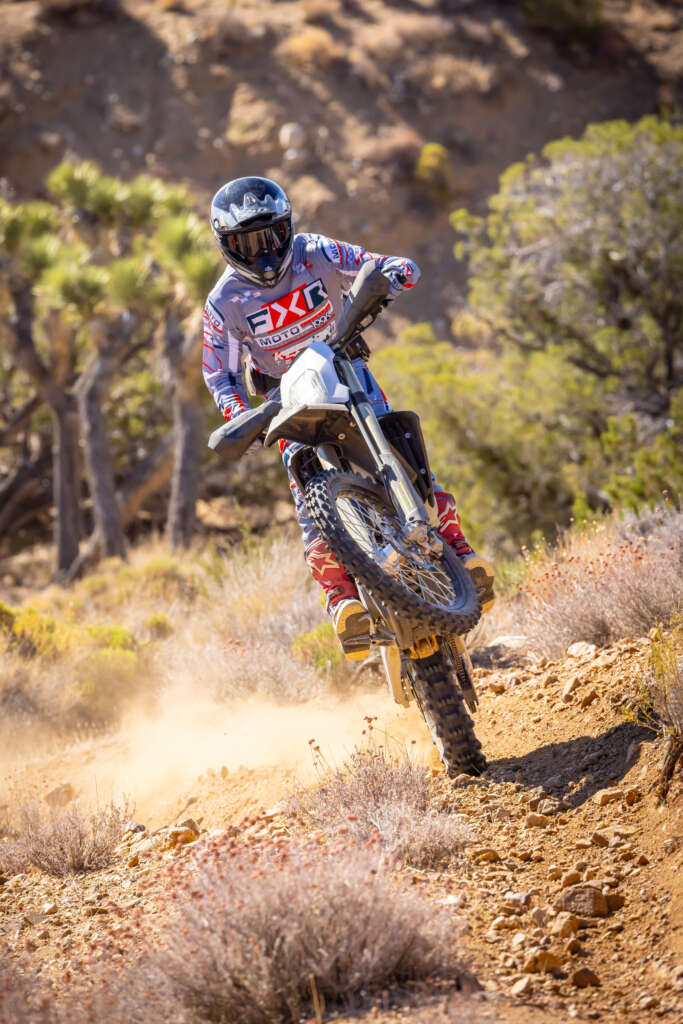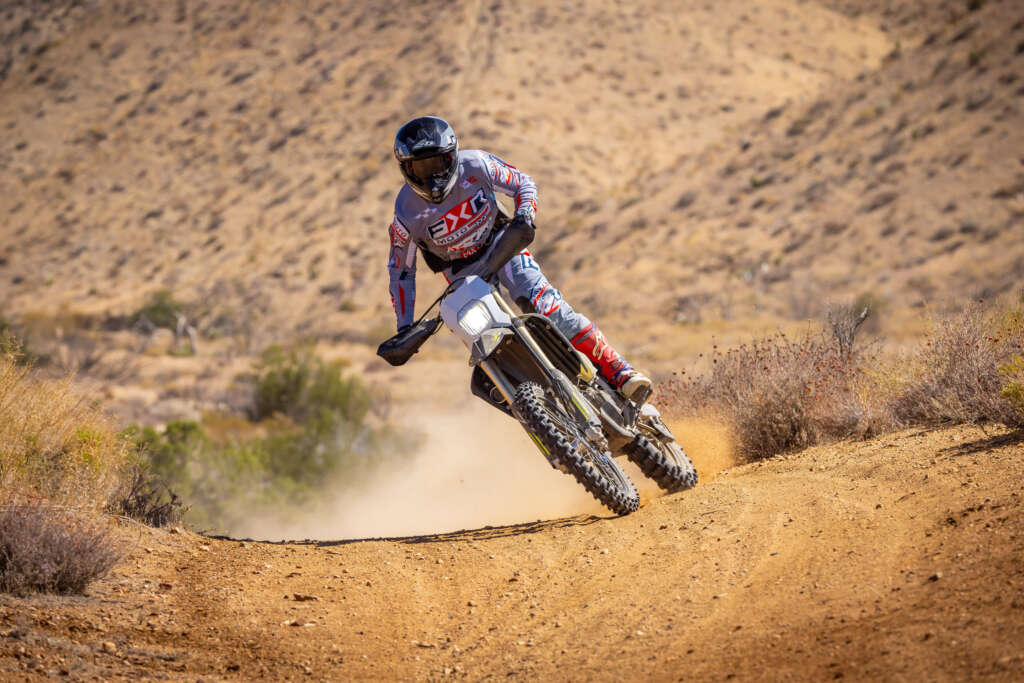Written By: Michael Allen
Not everyone has had the opportunity to experience a new bike introduction, so I consider myself very fortunate to have gotten the call from Kris asking me if I’d like to attend an upcoming event. Needless to say any new bike intro sounds exciting, but when he told me it was going to be the 2026 Triumph TF 450E, I was ecstatic. Although Triumph had a rich history of desert racing in the 1950s and 60s, I still consider them new to the off-road segment of motorcycling and I’ve always been interested in new, different bikes and how they work compared to the main Japanese and Austrian brands. The way I see it, the more manufacturers that are in the off-road market the better. It means more jobs and more options for us riders to choose from when we spend our hard-earned money. The only experience I had with Triumph prior to this test (aside from riding a Speed Triple in 2005) was a short off-road ride on Christmas Eve when Kris let me spend about 15 minutes on the 250F motocross bike. I was surprised then at how much I enjoyed it so I couldn’t wait to head the southern California desert and ride Triumph’s first off-road bike since their famous “Desert Sled”.

The first thing that was made clear during the presentation of the bike was that Triumph is fully invested into not only joining the off-road community, but also that they strive to be one of the best in the world. With their off-road team in Europe led by famous racer Paul Edmonson already seeing success, success in the Italian championship and their American motocross and Supercross efforts landing them on multiple podiums, it’s clear that they are here to stay.
It’s no secret that aside from the Austrian brands, when most companies make their off-road competition models they usually start with a motocross bike, install an 18” rear wheel, change the suspension settings, add a kickstand and BOOM there’s your off-road bike. In my opinion Triumph approached it the right way; by asking their off-road test riders what people really want, and doing their best to fulfill the riders wishes. While the frame and suspension (components not settings) are the same as the motocross bike, a lot of the engine and transmission are geared (pun intended) towards making the bike off-road specific. The crank on the 450 has 30% more inertia to smooth out the power for off-road conditions, the cams have a specific off-road profile along with a low stretch highly durable D.I.D. cam chain and hydraulic cam chain tensioner, the cylinder head has optimized port shapes, the stator cover has been changed for the larger alternator package as well as the clutch cover has been changed for decreased noise and vibration. Triumph also claims to have class leading horsepower with the 450E making 58.5hp @9750rpm and 36.4 ft lbs. of torque @7000rpm. The transmission not only has an additional gear, but all of the gear ratios have been made specific to the off-road models. Like the MX model the off-road bike comes equip with “Quick Shift” that aids clutch less upshifts from 2nd through 6th gear. The shift forks spring load selector are Moly coated to aid in a better shifting feel.
On the outside, the 450E’s air filter can be changed without tools, it also comes with a specific off-road exhaust system that is tuned for both performance and noise compliance (more on that later). The bikes will be delivered to their US dealers with a horn, although we were told that the dealers may opt to remove them during the bikes PDI. Being the off-road enthusiast that I am, I was thrilled to see that they come standard with durable handguards, kickstand, a skid plate as well as a tail and headlight (that’s actually bright). Pro Taper EVO bars with Triumph bar pad are standard, along with ODI ½ waffle grips. With the start/stop switch on the right side of the bars, the buttons on the left side allow you to use launch control, quick shift, traction control, and toggle between two pre-set maps on the fly. Another feature that makes this bike a true off-road bike is the digital readout that shows MPH, trip, hours, neutral and low fuel. The bike comes equipped with 90/90-21” and 140/80-18” tires Michelin Enduro 2 tires that are a new casing and compound. The tires are mounted on DID Dirtstar rims laced to in house machined 6000 series hubs. The brakes and clutch are Brembo, with Galfer disks, and the final drive is a 13/51. Triumph also has an app that will allow you to adjust the mapping of the bike via cell phone (think Yamaha power tuner). For noise and emissions, the air box cover on the 450E is solid, but it comes with a vented cover that allows the bike to breathe slightly better. Along with enduro specific numberplate/headlight, it also comes a small rear fender extension below the tail light to help control flinging mud. The tail light doesn’t just light up when the bike is on, it actually functions as a brake / tail light using a brake pressure switch at the rear brake pedal which led me to ask the presenter if there would be a dual sport coming down the ling to which he responded “I cannot confirm nor deny that we are working on a dual sport model”. Fuel capacity on the 450E is 2.19 gal which is slightly more than the motocross model. Triumph also has the bragging rights of having the lightest off-road competition bike coming in at 258 lbs. with fuel.

Now that you have all the details about the new Brit in town, we can get to what you really care about; how it performs on the trail. If you have read any of my articles in the past you know that I’m a desert rat and I grew up riding the Southern California desert. So, when we were told that the introduction was going to be in the same place I was raised riding, I was ecstatic because I’d really get a good feel for how the bike performed since I was so familiar with the area. Being that its mid-July in So Cal we had to beat the heat and start the ride early so we were up at 6am and riding by 8am. Triumph had a great loop that was roughly 10 miles that took 20-30 minutes to complete that consisted of a variety of terrain which allowed us to evaluate the bike in a multitude or conditions from fast single track to tight rocky trails, side hills and a monstrous Hillclimb.
One of the most impressive parts about the 450E is the engine and its ability to be so versatile. Down low the engine is smooth and the extra mass of the crank is noticeable as without dragging the clutch there’s no on/off sensation when riding rock beds where some bikes would have an jerky feeling with any throttle modulation (or even want to cough and die). Moving from bottom to mid the engine continues to be very smooth and linear which initially had me assuming that it was going to be a very mild power more like a WR, which likes to be softly ridden and doesn’t pack any punch, but to my surprise when you really open the throttle and ask the bike to get up and go, it comes alive. Triumph somehow seems to have made a great mix between the Yamaha WR and the Yamaha FX that I didn’t know was possible. The engine on this bike can seemingly be easily trail ridden and remain very smooth and user-friendly while being capable of lining up at a National Hare and Hound race and be just as capable as any manufacturers off-road competition bikes. The only real downside to the Triumph’s powerplant is that the over-rev is very abrupt. What I mean by this is that when hill climbing and really revving the bike I feel like the rev limiter reached the power cut off quickly.
To combat this, I just had to make sure to shift slightly sooner that originally anticipated. For being a 450 the engine braking is very light, which I like because when engine braking is abrupt it can create a pitching sensation, but I never felt that on the 450E. The 6-speed transmission seemed to have a good gear spreads with a very usable 1st gear what didn’t feel like a granny gear that some off-road bikes have which renders them useless. That being said I tended to use second gear in tighter terrain since the TF450E is so smooth. The only gear gap that was slightly large was the jump from 5th to 6th which is as it should be since it’s essentially an overdrive gear (actually its 1:1). You can comfortably cruise in 6th gear at 60mph without feeling like its being rung out or making the chassis feel nervous. To my surprise, 6th gear was tall enough for me to look down at the speedometer on a dirt road and see 101mph.
Shifting on the Triumph did seem a bit notchy when under power and at times was difficult to upshift under full power even while using the clutch. Using the quick shift function made this slightly better but with less clutch shifting was still difficult to power shift. When I brought this up to the Triumph team they told me that the bike becomes easier to shift after it has about 2 hours on it. The only other oddity that I noticed was that the clutch lever has some judder sensation when the bike is revved. This sensation was mostly felt when I was riding and would pull the play out of the lever just before the clutch would actually begin engagement. The lever would judder slightly and when the bike was revved the lever would move inward slightly. This sensation didn’t affect that way the clutch or bike performed, but was just something I noticed throughout the day.

Triumph started with a blank canvas when it came to the chassis of their off-road line of bikes and brought in the legendary Dave Arnold to help design the new aluminum chassis. The frame is tig welded by hand and shares the same geometry as the MX models although the off-road bikes have added the side stand mount, steering head lock (for anti-theft) as well as having additional mounts and threaded holes for mounting the skid plate. We haven’t seen a backbone chassis since the 2009 Yamaha 450, in fact a little birdie told me that this frame was inspired by that Yamaha chassis, as the characteristics of the 2009 Yamaha chassis were quite good. As a fabricator myself I was very impressed by the quality of the machining and welds themselves. Where at times other manufacturers aluminum frames can seem stiff which creates a harsh or jarring feeling through the bars, the TF 450E has none of that and is very compliant whether is absorbing rock gardens or landing from 6 feet in the air. It’s rare that you come across a bike that works well in technical terrain while still being stable at 100 MPH but I never felt the chassis do anything that I didn’t like. The locking mechanism on the steering head is a welcomed addition as I could see myself using it when out camping at night when I would want to lock it up before going to sleep. The side stand is different for the American market as it doesn’t stay down without the bikes weight leaning on it. I was told by Triumph that this is a standard in Europe. The bikes in Europe either have to have a switch that will not allow the bike to start if the stand is down, or it has to have a kick stand that will retract to the up position when the bike is not leaning on it. While I understand the theory behind this, it was quite annoying that any time I wanted to move the bike a little bit, that kick stand would automatically spring up. Also when it’s in the up position, if not secured by the rubber strap, it seems a bit floppy, like it may swing down on hard landings.
For suspension, Triumph opted to go with KYB for the fork and shock which I think was a great choice. I was told by the KYB rep at the intro that the fork is very similar to what Yamaha uses on their latest off-road bikes. I set the sag at 102mm (recommended by KYB) and to my surprise I didn’t touch the clickers all day. Initially the bike seemed maybe a little soft at the beginning of our loop, not because it was wallowy or spongy feeling, but because it was so compliant in the slower speed terrain I assumed it was going to blow through the travel once speeds picked up. To my surprise the more I pushed the 450E it seemed to keep up just fine. Don’t get me wrong, I wasn’t hitting Supercross whoops, but when I would jump off small cliffs, jump trail obstacles, or accidentally have an oh shit moment, the bike never felt out of control. It’s very uncommon for a designated off-road bike to have such balanced suspension settings out of the box that are capable of not only providing comfort, but also allowing for performance at speed. The rebound is definitely a tad fast which isn’t necessarily bad as it helps track so well in rock gardens, it also gives the bike a lightweight fun and playful feeling as you can hop over obstacles. The only negative that I felt was that the rear of the bike could have used a little better bottoming resistance. Where I noticed this was when wheeling into a large high speed whoops, the back of the bike somewhat abruptly bottomed which then transferred that energy into pushing the front of the bike down which was a little unexpected. I look forward to getting some more time on the bike to tinker with the clickers a bit. The 450E has billet triple clamps (which require more pinch torque that other bikes) which on some bikes can cause the bike to feel ridged, but I never experienced that sensation.
The rider triangle on the 450E felt very familiar and comfortable. The only adjustment I made to the bike was to slide the switches on both sides in to allow for me to move both the front brake lever and clutch lever inward so that I had better leverage on the levers. The handguards are just as good as the ones that come stock on the Austrian bikes and mount the same way to the perch which is quite strong. I did notice the gripper seat doing just what it’s made to do; grip. I never slid back on the seat, even when sitting down up steep climbs, and at the end of the day I had a bit of monkey butt from how much traction it had. The Brembo levers are just the right thickness to be comfortable and not sharp like some other manufacturers. Something I found fascinating is that Triumph seems to have made an off-road bike with a factory muffler that has a spark arrestor without choking the bike up and affecting the performance. At idle its fairly quiet and while on the trail its loud enough to hear it but not annoying. When you really open the throttle it has a distinct tone that I can only explain as quietly loud. While I’m sure an aftermarket exhaust would help the power, I don’t think it would be worth the additional decibels (mind you I like quieter bikes). The switches are all easily accessible while riding, but since I wasn’t very familiar with their location, I had to stop to see what I was pressing. The only function I did not try throughout the day was the launch control. I did try the softer map which would be helpful in slipperier conditions. Also to my surprise I liked the traction control function, I don’t think it’s something you’d want while hill climbing where you want that extra wheel spin, but on the slippery, dry flat turns, it really helped the bike minimize how much the rear end stepped out when on the throttle. Speaking of grip, although I had a pre conceived notion that the Enduro tires were going to be pretty bad, to my surprise, for how dry the desert was, they tracked straight and actually had pretty good traction. The only place they weren’t ideal is when I would dig a little hole and need to climb out of it, they just seemed to spin and not get very good traction.
After spending the day riding a very fun loop laid out by Mike Webb and Brian Palmer, I came away shocked at Triumph’s first shot at the off-road market. It’s very clear that they left no stone un turned in making a great motorcycle. I’ve tested a lot of bikes over the years and I like the TF 450E so much that it may be the best out of the box, off-road 450 I’ve ever tested, in fact if I were in the market for a 450 off-road bike the 450E would be at the top of my list. The only thing we don’t know is how durable the Triumph bikes will be, but that’s only because they are so new to the market. My plan is to ask Triumph if I could get a bike and put together a 24hr of Glen Helen team and race the bike in completely stock for, headlight and all. This would I think give Keefer Inc. a bit more time to see how we like it and maybe give Triumph some data that they can put into future models. Coming in at $10,795 The Triumph is more than competitive with other manufacturers so what I will leave you with after my day riding the bike from across the pond is was what the great Paul Revere shouted on his midnight ride; “the British are coming, the British are coming”. So someone let the Austrians, Spanish, Italians and Japanese that the British are indeed coming, and before too long they will be knocking many well-known brands off the podium.

Brilliant
- Smooth power delivery
- Great chassis balance
- Comes with a bright headlight
- Competitive pricing
- Fun to ride
- Capable of over 100MPH stock
Bollocks
- Notchy shifting
- Clutch Judder
- Could use better tires
- Odd kickstand
- Abrupt rev-limiter
- Slightly limited fuel capacity
